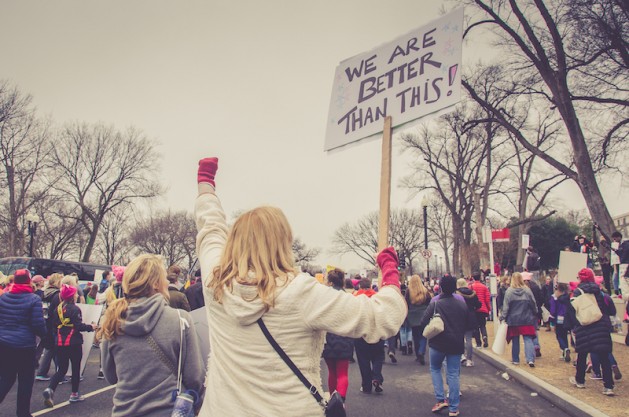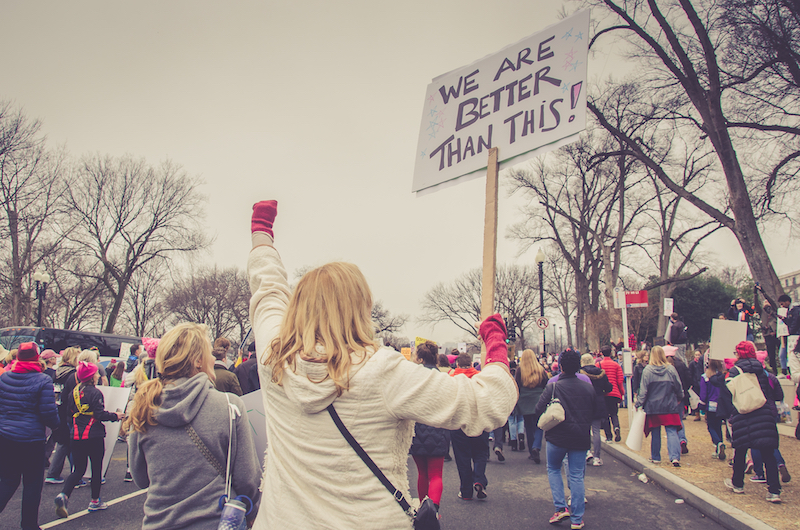
We are hearing a lot about feminism these days (good thing, too). But have you ever wondered the history of feminism? Feminism is one of those topics that gives rise to a lot of misunderstandings. As a guy, for instance, I can tell you that for a long time the first thing that sprang to mind when I thought of the word was angry women burning bras and yelling about systematic oppression from the patriarchy. It’s wasn’t a very informed impression (then or now), but I promise it’s one a lot of guys share.
And luckily, I got the chance to get informed on the issue during a class back in college. You might imagine it was a woman’s studies class or something like that, but it was actually history. And as someone who liked history enough to major in it, I can tell you that if you want me to care about a current issue, start telling me about the history of it.
In that history class, my teacher asked who considered themselves a feminist. Not caring so much about patriarchy and not the kind of person who goes out of their way to involve themselves in social issues at all, I didn’t put my hand up.
But it was then that someone took the time to lay out feminism in a way that made me feel like a jerk for not calling myself a feminist, which is something I never thought would happen. A woman in the class explained it this way: feminism is the idea that men and women should have access to the same rights and opportunities as men. And a feminist is someone who agrees with that.
I got this lesson right before studying the history of the 1960s and feminism was a big part of that. And that really helped me understand why so many women would take to the streets to demand equal rights. And if you’ve never taken the time to learn about some of the basic history of feminism, you’re missing out on a chance to really understand the movement.
But if you’re interested in the subject, here’s a quick rundown of the history of feminism and how it relates to the present day.
History of feminism
Feminism is typically divided up into three “waves.” Each wave reflects a broad direction of the movement as well as what people within it understood of as the “goal of feminism.” And it’s a pretty useful way to break down the history of feminism. So, let’s look at the three waves and what was going on in each.
First Wave: Suffrage
You probably know that women weren’t always allowed to vote. What you might not be aware of is just how recently that was true. Take Switzerland, for example. In one of the oldest democracies in the world, women didn’t win the right to vote until 1971.
And while the women of Switzerland had to fight a little longer than most for access to one of the most basic rights, suffrage (or the right to vote) formed the basis of the feminist movement all over the world. And in the United States and England, suffragettes laid the groundwork for the feminist movement.
The basis of the fight for suffrage was the idea that women deserved the same rights as men. And while the idea that men and women should have the same political rights is taken for granted today, at the time, women lacked many of the rights that men did. For instance, if a married couple got divorced, the woman had no right to ask for custody of the children and a man could (and many did) involuntarily commit his wife to a mental institution simply by taking her there and declaring her insane.
And this imbalance of rights between men and women is what the suffragettes in the first wave of feminism were fighting. For the first time, women were standing up and saying en masse that they deserved the same rights as men.
Of course, this movement peaked in the 1920’s, when women finally won the long struggle for voting rights. And this early victory set the stage for the second stage of feminism.
Second Wave: Liberation
The 1960’s was a period when the Western world began to re-examine the traditional power structures in their societies. And though women had come a long way in winning basic political rights, they now began to fight against a more pervasive and elusive enemy: systemic sexism.
Women, on paper at least, had all the same rights as men. Yet, in practice, they were far from equal. Women earned substantially less than men and they had a much harder time attaining a career. This led to the second wave of feminism when women began speaking out against these invisible barriers that had long held them back.
They had won equal rights, but now they wanted true equality. Second wave feminists fought to pass legislation that would require that professional programs admit them on the same grounds as men and to make discrimination against women for jobs illegal. And in spite of the serious backlash from people from all ranks of society, they finally got that legislation with the Civil Rights Act in 1964 which made gender-based discrimination illegal.
Third Wave: Freedom of Choice
The third wave of feminism was really a response to this victory by the second wave feminists. Now that women had won the legal protection necessary to have successful careers, women began entering the workforce in numbers that they never had before.
As a result, there began to form a cultural impression that because women could work outside the home, they should. Women in the feminist movement were now arguing that women had not only a right to work in a fulfilling career but an obligation to do so because it furthered the march of equality for all women.
But there were many women who disagreed. A new movement called third wave feminism was born that said, “women can do anything they want to, so that’s exactly what they should do.” Third wave feminists wanted women to be able to define feminism for themselves and fight for equality in any way they saw fit.
While a second wave feminist would say to a young woman, “go out and find a career that leaves you fulfilled and successful enough that you can be truly independent,” a third wave feminist would say, “if you want to work outside the home, do it. And if you want to stay at home and raise your children because you find that fulfilling, you should be able to do that too.”
So where second wave feminism was focused on getting women the right to work, third wave feminism was about getting women the right to have families. They fought for things like maternity leave and an end to the attempt to force women into filling a social niche they didn’t want.
And that’s more or less where we are now with feminism, a movement to see to it that women have the freedom to do whatever makes them happy. And to make sure that they have the same right to that happiness that a man would.



